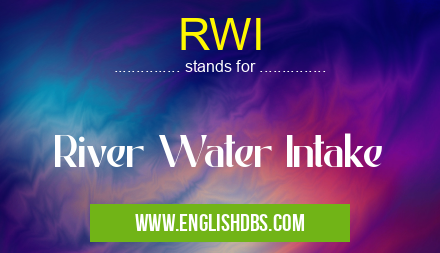What does RWI mean in UNCLASSIFIED
RWI stands for River Water Intake. It refers to the point where water is drawn into a water supply system from a flowing river.

RWI meaning in Unclassified in Miscellaneous
RWI mostly used in an acronym Unclassified in Category Miscellaneous that means River Water Intake
Shorthand: RWI,
Full Form: River Water Intake
For more information of "River Water Intake", see the section below.
Purpose
RWIs are essential components of water supply infrastructure, providing a reliable source of raw water for drinking, industrial, and agricultural purposes. They are designed to minimize the risk of contamination and ensure that water is suitable for treatment and consumption.
Design and Construction
RWIs typically consist of the following components:
- Intake structure: A submerged or partially submerged structure that houses the intake pipe and screening system.
- Intake pipe: A large-diameter pipe that conveys water from the river to a treatment plant or reservoir.
- Screening system: A series of screens that remove debris, such as fish, vegetation, and trash, from the raw water.
- Control system: Monitors and adjusts the flow of water into the supply system.
Types of RWIs
There are several types of RWIs, each designed for specific conditions:
- Bank Filtration: Water is drawn from the river through a well located near the bank, allowing natural filtration through the soil.
- Submerged Intake: A submerged structure houses the intake pipe and screening system, which is located deep in the river to minimize sediment and debris.
- Floating Intake: A floating structure is anchored in the river and houses the intake pipe and screening system, which are suspended above the riverbed.
Benefits
RWIs offer several benefits:
- Provide a reliable source of raw water for communities and industries.
- Reduce the risk of contamination by screening out debris and microorganisms.
- Allow for the treatment and purification of water to meet drinking water standards.
- Support aquatic ecosystems by maintaining water flow and providing habitat for fish and other organisms.
Essential Questions and Answers on River Water Intake in "MISCELLANEOUS»UNFILED"
What is River Water Intake (RWI)?
RWI is a facility that draws untreated water from a river to supply raw water for various purposes, such as drinking, irrigation, and industrial operations. It typically consists of a pump station, intake structures, and pipelines to convey the raw water to the treatment plant.
Why is RWI important?
RWI is crucial because it provides a source of water for communities, industries, and agriculture. Rivers are often the most accessible and reliable source of water, especially in areas with limited groundwater resources or during droughts.
How does RWI work?
An RWI system typically involves the following steps:
- Intake Structures: Water is drawn from the river through intake structures that can be located at the riverbank, in a dam, or in a diversion channel.
- Pump Station: Pumps are used to lift the water from the intake structure and into pipelines.
- Conveyance Pipelines: The raw water is conveyed through pipelines to the water treatment plant.
- Treatment Plant: The raw water undergoes various treatment processes to remove impurities and make it safe for consumption or other uses.
What are the challenges associated with RWI?
RWI faces several challenges, including:
- Water Quality: River water can be contaminated with pollutants, such as bacteria, chemicals, and sediment.
- Seasonal Variations: River flow can fluctuate significantly throughout the year, which can affect the availability of water.
- Environmental Impact: RWI can have potential environmental impacts, such as disrupting river ecosystems and altering the natural flow of water.
How can RWI be improved?
RWI can be improved through various measures, such as:
- Advanced Water Treatment Technologies: Implementing advanced treatment technologies can help remove more impurities and improve water quality.
- Water Monitoring and Management: Monitoring water quality and implementing water management strategies can help ensure the availability of clean water.
- Environmental Conservation Practices: Protecting river ecosystems and restoring natural habitats can help sustain the source of water for RWI.
Final Words: RWIs play a crucial role in providing clean and reliable water supplies. By drawing water from rivers, they ensure that communities have access to essential resources while minimizing the risk of waterborne illnesses. Proper design, construction, and maintenance of RWIs are essential to safeguard public health and support sustainable water management.
RWI also stands for: |
|
| All stands for RWI |
